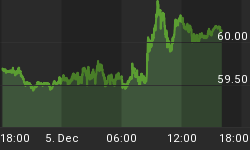In the preserved, written work of George Lindsay, Lindsay makes several references to an approach he calls "mirror image". Unfortunately, the most he ever wrote was that he had never explained it in writing but hoped to someday. If he did, it has been lost to time. This is why the topic has not appeared in any of my three books about his work.
However, discussions with those who knew him, combined with a little common sense and attempts to re-create this approach have yielded some good results.
The simplest explanation involves forecasting lows (not shown). Counting from an obvious low to the highest point prior to a downturn will often find an obvious low the same number of calendar days beyond that high. It's not a perfect forecasting method but when it's right, it's rarely off by more than three days. None of Lindsay's methods were meant to be used in isolation but this simple method combined with your own methods and a little common sense (don't expect a low if the market is advancing) can yield some fascinating results.
The chart below shows mirror image counts, centered on the bull high in 2007, forecasting highs. While counting from a high might be the expected approach (and is often the case) you can quickly see that's now always the case. Counting to highs uses the typical approach of Middle Sections which is explained in any of my books.
Obtain your copy of the August Lindsay Report at SeattleTA

















